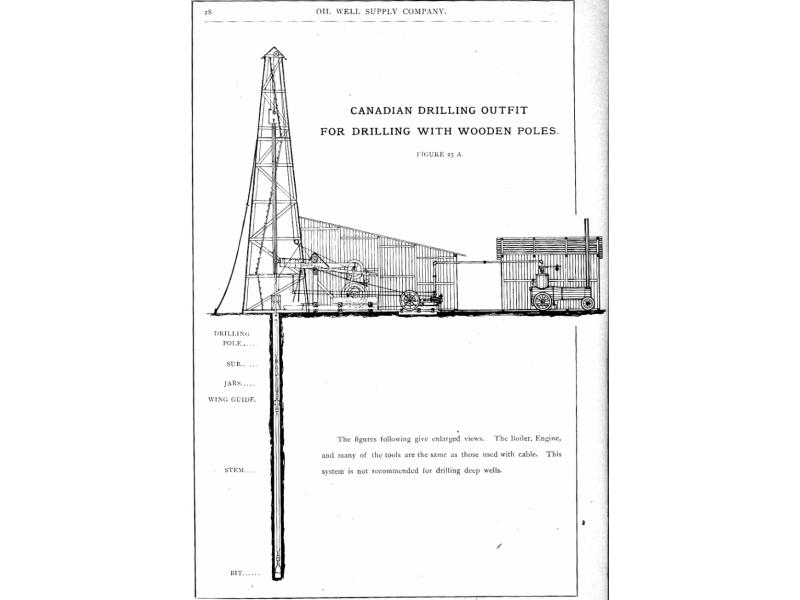Of all the innovations to come from Lambton County, the Canadian pole-tool drilling method possibly had the largest impact in oil fields around the world. The Canadian pole-tool drilling method was based upon a beautifully simple design. The rig was a four-pole derrick stabilized by cross beams and, to make the rig easier to traverse across the muddy fields of Lambton County, it was equipped with sled-like runners, allowing it to be dragged across the land.
The rigs themselves were powered by steam engines. Steam powered an engine, using the engine’s strokes to turn a flywheel. The flywheel moved a belt that moved the drill wheel. A camshaft mounted to the drill wheel converted the circular motion of the drill wheel into vertical motion, causing a walking beam to pound a drill bit through solid rock. As the bit went deeper, drill rod extensions, made from black ash poles with iron connectors, could be added to drill wells as deep as 3,500 feet. It was these black-ash poles that gave the rig its name and differentiated it from other drilling methods.
The cable-tool drilling method, in which the drill bit was attached to either manila rope or steel cable rather than ash poles, was the earliest method of drilling wells and used throughout the early American oil fields. The Canadian pole-tool drilling method, by comparison, was introduced to the Ontario oil industry in 1866 by William H. McGarvey in response to the challenging drilling conditions presented by the hard bedrock. The ash poles would keep the drill bit straight when drilling through the hard rock whereas a cable tool, due to the flexibility of the line, would choose the path of least resistance, creating an uneven oil well. It was because of these advantages that the Canadian pole-tool drilling method was first sought after by oil companies operating in Galicia (modern Poland and Ukraine), where soil conditions were similarly challenging.
Once the Canadian pole-tool drilling method proved itself, Canadian drilling experts found themselves in demand all over the world. A Lambton County business called the Oil Well Supply Company fabricated drilling rigs which used the Canadian pole-tool drilling method and shipped them to oil fields around the world. From the Russian Steppes to the jungles of Borneo, the Canadian pole-tool drilling method could be found wherever the International Drillers went.
If the drillers couldn’t order the parts necessary to build these rigs, then they would make their own Canadian pole-tool drilling rigs using whatever homemade tools and local materials available. When International Driller Fred Edward couldn’t find the wood needed to build a Canadian system rig in the deserts of Egypt, he ordered British steel and fabricated one using homemade tools.
In the late 19th century, the oil industry was in its infant stages and oilmen had to develop new tools, technologies, and techniques as they encountered each new challenge. As a result of their expertise and forward thinking, Canadians became renowned as pioneers in oil drilling technology.



 A Canadian Pole-Tool Drilling Rig in Petrolia
A Canadian Pole-Tool Drilling Rig in Petrolia  A Canadian Pole-Tool Drilling Rig in either Oil Springs or Petrolia. The ash poles can be seen leaning again the inside of the rig.
A Canadian Pole-Tool Drilling Rig in either Oil Springs or Petrolia. The ash poles can be seen leaning again the inside of the rig.  The Canadian drilling outfit, illustrated in the Oil Well Supply Company's Catalogue, 2nd ed.
The Canadian drilling outfit, illustrated in the Oil Well Supply Company's Catalogue, 2nd ed.  The Canadian drilling outfit, illustrated in the Oil Well Supply Company's Catalogue, 2nd ed.
The Canadian drilling outfit, illustrated in the Oil Well Supply Company's Catalogue, 2nd ed.  A cut-away view showing the inside of a derrick, from the Oil Well Supply Company's Catalogue, 2nd ed.
A cut-away view showing the inside of a derrick, from the Oil Well Supply Company's Catalogue, 2nd ed.  An engine and boiler, used to operate the machinery of the drilling rigs.
Source: Oil Well Supply Company Ltd., Petrolia Catalogue, 1917.
An engine and boiler, used to operate the machinery of the drilling rigs.
Source: Oil Well Supply Company Ltd., Petrolia Catalogue, 1917.  A man drives a steam traction engine to the site of a drilling rig.
A man drives a steam traction engine to the site of a drilling rig.  A group of Egyptian labourers haul a boiler through the desert to the drilling rig.
A group of Egyptian labourers haul a boiler through the desert to the drilling rig.
Add new comment